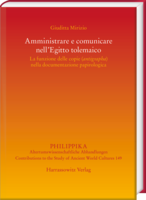|
|
This study investigates a particular pattern of communication, employed for the exchange of information between the offices of Ptolemaic Egypt: the “cascade-letters”. This definition refers to the mechanism of appending copies of letters by reproducing them in the same sheet of papyrus, often in chronological order. This template, which relates to certain stylistic, textual, visual and material features, is frequently introduced and marked by the formula “ἀντίγραφον ὑπόκειται”, “a copy is subjoined below”, of which there are many parallels.
The attempt to retrace the intentions for the adoption of the model and the stages of its evolution from the third to the second century B.C. constitute the core of a diplomatic-administrative research on official epistolography. The philological and historical analysis of the texts contributes to the interpretation of the documents characterized by a multi-layered transmission of notifications. Far from being a mechanical reproduction of the texts that were to be multiplied, this scribal practice responded to basic needs of the Ptolemaic administration, which included the aspect of control of various collaborating sectors and that of the authentication of the forwarded communication. |






